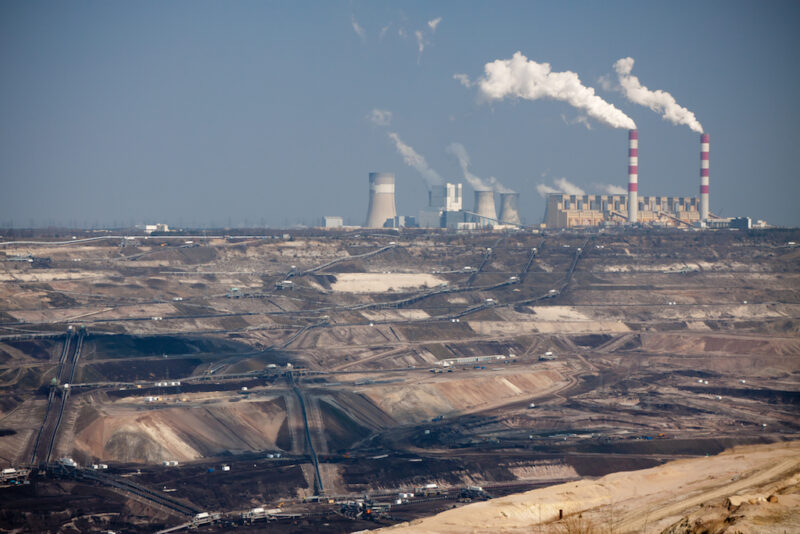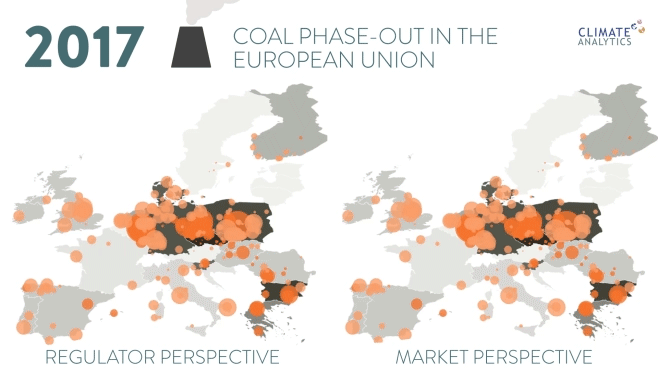EU needs to shut all coal plants by 2030, or will vastly overshoot Paris Agreement - report
Share

The report – A stress test for coal in Europe under the Paris Agreement, by climate research institute Climate Analytics, sets out the first science-based analysis of when – and where – each of the EU’s more than 300 coal power plants would need to be phased out.
Climate Analytics has calculated that to stay within the Paris Agreement’s long term temperature limits of “well below” 2˚C and “pursuing efforts to limit the temperature increase to 1.5°C,” the EU’s C02 emissions budget for coal in the power sector is around 6.5Gt by 2050. The EU will exceed its Paris Agreement-compatible coal emissions budget by 85% if its existing coal-fired power plants continue operating to their full lifespan.
“Not only would existing coal plants exceed the EU’s emissions budget, but the eleven planned and announced plants would raise EU emissions to almost twice the levels required to keep warming to the Paris Agreement’s long term temperature goal,” said Dr Michiel Schaeffer, Climate Analytics Science Director, presenting the report at an event in Brussels today (1).
The report shows that emissions from coal in the EU electricity sector need to be close to zero by 2030 (95% by 2030; 100% by 2031), with a quarter of operating coal-fired power plants switched off before 2020 and a further 47% going offline by 2025.
“We find the cheapest way for the EU to make the emissions cuts required to meet its Paris Agreement commitments is to phase out coal from the electricity sector, and replace this capacity with renewables and energy efficiency measures,” said Paola Yanguas Parra, a lead author of the report.
“Germany and Poland have the most work to do on a coal phase-out: they are jointly responsible for 51% of installed coal capacity and 54% of emissions from coal.”
The report outlines two possible pathways showing how the EU could achieve a complete coal phase-out, and proposes a shutdown date for each of the EU’s 315 power plants (738 generating units in total) (1).
One pathway is based around a ‘market’ perspective, where the economic value of the plant is prioritised over its emissions intensity, and the other is based on a ‘regulator’ perspective, where plants with the highest emissions intensity are phased out first. Both yield a phase-out of coal by 2030, but the date each specific plant goes offline differs significantly between the two approaches, with different potential impacts on regions within a given country.
To achieve this ambitious phase-out schedule, the EU will need to design enhanced policy settings and approaches that complement each other, including:
- a more effective EU Emissions Trading Scheme
- a stable and predictable investment framework
- bigger targets for renewables – instrumental in a successful coal phase-out
- strategies and policies at both national and regional level to ensure a smooth transition and maximise usage of socioeconomic opportunities.
Substantial human, institutional and financial resources will need to be devoted to maximise the economic, social and environmental benefits of this essential transformation of the energy sector.
“It is remarkable that for 25 years the European Union has led the way globally on climate change policy, be it in mitigation or adaptation, the legal structures of international agreements, or financing actions in developing countries. Its next big challenge is to lead the way on meeting the 1.5°C limit, holding warming “well below 2°C” as agreed in Paris,” said Bill Hare, CEO of Climate Analytics.
“This new and innovative plant-by-plant analysis shows that one of the biggest challenges for Europe will be the phase-out of coal fired-power emissions by 2030. For any country, in any region, and at any time this would be a major challenge, both economically and politically.”
“However, the EU already has many of the key policy instruments in place, including those required for fair and just transition strategies. The challenge now is for Europe to capitalise on its massive investments in climate policy, seize the opportunities created by a coal phase out, and use its institutions to ensure all regions benefit from this.”

Germany
“Germany is Europe’s largest consumer of coal. It has built a number of large coal power plants in the last 15 years and another large one could come online in 2018. Our analysis shows that these plants will need to be shut down long before the end of their lifetimes to stay within the Paris Agreement long term temperature goal,” says Niklas Roming, one of the report authors. “This is already implied by the German Climate Action Plan 2050, whose implementation needs to take account of the findings of our analysis,” says Niklas Roming, one of the report authors.
Poland
“While coal provides 85% of Poland’s electricity it is facing growing extraction costs, dwindling reserves and increased competition from renewables, as well as large environmental and health impacts, the Polish government is still favouring coal as the future mainstay of Polish electricity supply. Implementing the Paris Agreement means that Poland cannot go ahead with its plans for new coal plants, and instead needs to start planning for a phase out,” says Dr. Andrzej Ancygier.
Policies at the EU and national level for the EU-ETS and Renewable Energy need to be complemented by long term planning for a sustainable transition, in particular, for the regions most affected.
He noted that while a transition would be challenging, there were numerous possibilities to replace coal, especially given the significant decrease in the cost of wind and solar energy and the potential for biomass, all of which offered Poland an opportunity to make its power sector cleaner and more diversified.
“The necessary switch away from coal in Poland can have positive socio-economic implications. The alternatives in the renewable energy area and energy efficiency will produce large social, economic and environmental benefits that will be durable and lasting for the longer term. The European Union level policy approaches need to acknowledge these issues and ensure that adequate resources are provided for the transformation in Poland. In particular EU policies need to assist in developing structural alternatives and avoid structural breaks that would have negative socio-economic implications for some regions and create sustainable job opportunities.”
“Aside from job creation, a transition from coal to renewables will also make the Polish power sector more resilient to the threat of electricity outages experienced due to increased frequency of droughts and associated lack of cooling water for coal power plants.”
(1) The full list of phase-out dates for all units can be found here.
Note: some “plants” are on the same “site” or in the same “complex.” Sometimes they are considered different plants – sometimes with different owners – and in other cases they are considered the same plant. Financial ownership may shift and, with this, the number of “plants” may also change. Taking these considerations into account, we arrive at a number of 315 plants. Our analysis is based on the number of actual units: 738.
Executive Summary in German and Polish
All graphics available here.











